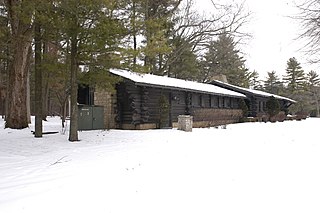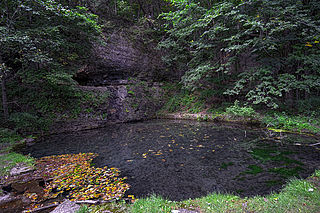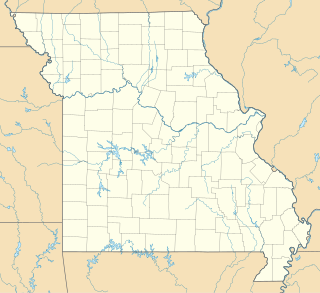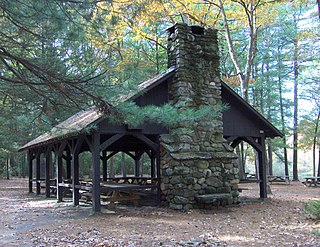
Chatfield Hollow State Park is a public recreation area occupying 412 acres (167 ha) that lie adjacent to Cockaponset State Forest in the town of Killingworth, Connecticut. The state park offers hiking trails, a swimming beach, trout fishing, mountain biking, rock climbing, and picnicking areas. Park attractions include 6.67-acre (2.70 ha) Schreeder Pond, Indian caves, historic sites, a restored water wheel, and a reproduction covered bridge. The park is managed by the Connecticut Department of Energy and Environmental Protection.

Meramec State Park is a public recreation area located near Sullivan, Missouri, about 60 miles from St. Louis, along the Meramec River. The park has diverse ecosystems such as hardwood forests and glades. There are over 40 caves located throughout the park, the geology of which is a mixture of limestone and dolomite. The most famous is Fisher Cave, located near the campgrounds. The park borders the Meramec Conservation Area.

Cumberland Mountain State Park is a state park in Cumberland County, Tennessee, in the southeastern United States. The park consists of 1,720 acres (7.0 km2) situated around Byrd Lake, a man-made lake created by the impoundment of Byrd Creek in the 1930s. The park is set amidst an environmental microcosm of the Cumberland Plateau and provides numerous recreational activities, including an 18-hole Bear Trace golf course.

Black Moshannon State Park is a 3,480-acre (1,410 ha) Pennsylvania state park in Rush Township, Centre County, Pennsylvania, United States. It surrounds Black Moshannon Lake, formed by a dam on Black Moshannon Creek, which has given its name to the lake and park. The park is just west of the Allegheny Front, 9 miles (14 km) east of Philipsburg on Pennsylvania Route 504, and is largely surrounded by Moshannon State Forest. A bog in the park provides a habitat for diverse wildlife not common in other areas of the state, such as carnivorous plants, orchids, and species normally found farther north. As home to the "largest reconstituted bog in Pennsylvania", it was chosen by the Pennsylvania Department of Conservation and Natural Resources for its "25 Must-see Pennsylvania State Parks" list.

The White Pines State Park Lodge and Cabins are located in rural Ogle County, Illinois near the village of Mount Morris. They were added to the National Register of Historic Places in 1985. The Cabins are one of two Historic Places found in or near Mount Morris, the other is the Samuel M. Hitt House. The Lodge and Cabins are part of a National Register Multiple Property Submission, they were submitted with several other state park lodges, all designed by Joseph F. Booton.

Backbone State Park is Iowa's oldest state park, dedicated in 1919. Located in the valley of the Maquoketa River, it is approximately three miles (5 km) south of Strawberry Point in Delaware County. It is named for a narrow and steep ridge of bedrock carved by a loop of the Maquoketa River originally known as the Devil's Backbone. The initial 1,200 acres (490 ha) were donated by E.M. Carr of Lamont, Iowa. Backbone Lake Dam, a relatively low dam built by the Civilian Conservation Corps (CCC) in the 1930s, created Backbone Lake. The CCC constructed a majority of trails and buildings which make up the park.

The Black Moshannon State Park Historic Districts are three separate historic districts on the National Register of Historic Places (NRHP) at Black Moshannon State Park in Rush Township, Centre County, Pennsylvania in the United States. The structures in the historic districts were constructed in the 1930s during the Great Depression by the Civilian Conservation Corps (CCC). The three districts are: the Beach and Day Use District, with 18 contributing structures, including 11 different picnic pavilions, concession building, bathhouse, museum, and four open pit latrines; the Family Cabin District with 16 contributing properties, including 13 cabins, one lodge and two latrines; and the Maintenance District with four contributing properties, including a storage building, three-bay garage, gas pump house, and ranger's residence.

Knob Noster State Park is a public recreation area covering 3,934 acres (1,592 ha) in Johnson County, Missouri, in the United States. The state park bears the name of the nearby town of Knob Noster, which itself is named for one of two small hills or "knobs" that rise up in an otherwise flat section of Missouri. Noster is a Latin adjective meaning "our"—therefore, Knob Noster translates as "our hill." A local Indian belief stated that the hills were "raised up as monuments to slain warriors." The park offers year-round camping, hiking, and fishing and is managed by the Missouri Department of Natural Resources.

Avery House, in Griswold, Connecticut, also known as Hopeville Pond Park House, was built around 1770. The house is a 20 feet (6.1 m) by 40 feet (12 m), the two-story central-chimney Colonial that was originally sheathed in clapboard and topped with a gable roof. The central chimney is on a stone base and has a built-in root cellar. Alterations in the house changed the traditional five-room first floor plan by eliminating the keeping rooms and the removal of the kitchen fireplace. It retains much of its original door frames and wrought-iron latch hardware. After the rehabilitation of the property, the Avery House became the Hopeville Park manager's residence and is a part of the Hopeville Pond State Park. It was listed on the National Register of Historic Places in 1986.

The Massacoe Forest Pavilion, also known as the Stratton Brook Park Pavilion, is a historic outdoor pavilion located in Stratton Brook State Park in Simsbury, Connecticut. It was built in 1935 by the Civilian Conservation Corps (CCC), and is a well-preserved example of the Corps' work. It was listed on the National Register of Historic Places in 1986.

The American Legion Forest CCC Shelter is a historic rustic log shelter, located on the west side of West River Road within the American Legion State Forest in Barkhamsted, Connecticut. It is the only surviving one of four such structures in the area built by the Civilian Conservation Corps (CCC), and one of only two CCC-built shelters to survive in the state. The shelter was listed on the National Register of Historic Places in 1986.

Hopeville Pond State Park is a public recreation area located on Hopeville Pond, an impoundment of the Pachaug River, in the town of Griswold, Connecticut. A portion of the 554-acre (224 ha) state park occupies the site of the lost village of Hopeville. The park manager's house occupies Avery House, which is listed on the National Register of Historic Places. The park offers fishing, swimming, camping, and trails for hiking and biking. It is managed by the Connecticut Department of Energy and Environmental Protection.

Upton State Forest is a publicly owned forest with recreational features primarily located in the town of Upton, Massachusetts, with smaller sections in the towns of Hopkinton and Westborough. The state forest encompasses nearly 2,800 acres (1,100 ha) of publicly accessible lands and includes the last remaining Civilian Conservation Corps (CCC) camp in Massachusetts, built in Rustic style. The CCC campground was listed on the National Register of Historic Places in 2014.

Topside is a historic summer estate in Brooksville, Maine. Designed by Tennessee architect William Crutchfield and built in 1918, this unusual log structure more closely resembles vacation houses found in the mountain areas of the southern United States than it those found in Maine. It is located on the north shore of Walker Pond, off Maine State Route 176. It was listed on the National Register of Historic Places in 1975.

The Paugnut Forest Administration Building is a historic building at 385 Burr Mountain Road in Burr Pond State Park, Torrington, Connecticut. Built in 1937 by a crew of the Civilian Conservation Corps (CCC), it is one of the finest examples of Bungalow/Craftsman architecture built by the CCC in the state. It was listed on the National Register of Historic Places in 1986.

The Peoples State Forest Nature Museum is a state-run museum on Greenwood Road in the Peoples State Forest in Barkhamsted, Connecticut. It features displays on forestry, plants and animals native to Connecticut, local history, rocks and minerals, and insects. The museum is open seasonally from Friday through Monday. The rustic style building was constructed in 1935 by the Civilian Conservation Corps and was added to the National Register of Historic Places in 1986.

The Cream Hill Shelter is a rustic log shelter in Housatonic State Forest in Cornwall, Connecticut. Built in 1988, it replaced what was at the time one of three surviving log shelters constructed by the Civilian Conservation Corps in Connecticut. The historic shelter it replaced, built in 1935, was listed on the National Register of Historic Places in 1986.

The Red Mountain Shelter is a historic rustic log shelter in Mohawk State Forest in Cornwall, Connecticut. Built in 1934, it is one three surviving log shelters constructed by the Civilian Conservation Corps in Connecticut. It was listed on the National Register of Historic Places in 1986.

The Tunxis Forest Headquarters House is a historic house on North Hollow Road Connecticut Route 20) in Hartland, Connecticut. Built in 1936, it is one of the few surviving houses built in the state by the Civilian Conservation Corps, and now serves as part of the headquarters complex of Tunxis State Forest. It was listed on the National Register of Historic Places in 1986.

The Tunxis Forest Ski Cabin is a historic ski lodge at the end of Balance Rock Road in Tunxis State Forest, Hartland, Connecticut. Built in 1937, it is one of the few surviving ski-related recreational structures built by the Civilian Conservation Corps in the state. It was listed on the National Register of Historic Places in 1986.






















